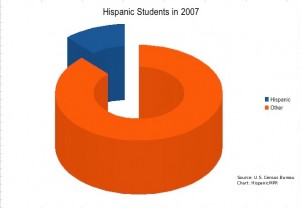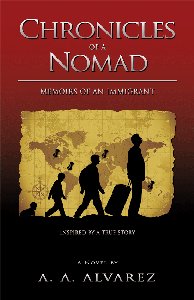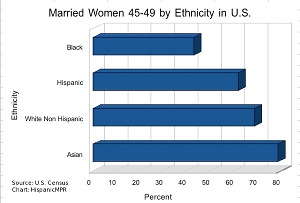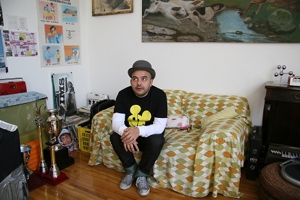Posted by Elena del Valle on March 9, 2009

Hispanic Students in 2007 - click to enlarge
In 2007, Hispanic students represented one fifth (12 percent) of kindergarten through high school students as well as full-time undergraduate and graduate college students. The number of college students represents an increase of 2 percent from 10 percent in 2006, according to U.S. Census Bureau tables released last week. These numbers are not surprising since Hispanics, even by conservative estimates, comprise 15 percent of the nation’s population.
The increase in Latino students is considered part of a trend of an increasing wave of emerging market or minority students across schools and universities nationwide. In 2007, there were twice as many minority (Hispanics, blacks, Asian-Americans) students in grades K-12 than 30 years earlier. Pre-college minority students in that part of the country exceeded mainstream students. By 2023, minority children are projected to be the largest percentage of children in the United States population.
Immigration and high birth rates among Latinos combined with shrinking birthrates among non Hispanic whites are resulting in changes in the school systems, especially in western states such as Arizona, California, and Nevada where 37 percent of students is Hispanic.
Nationwide, more than 23 percent of kindergarten students is Hispanic. At the same time, in 2007, more of those young students were U.S.-born than foreign-born. Fifty-four percent of students in New Mexico is Latino, 47 percent of students in California is Latino, 44 percent in Texas, and 40 percent in Arizona according to the latest data available.
“Marketing to Multicultural Kids” audio recording

Michele Valdovinos gives a presentation and participates in an extended Q&A discussion about multicultural children based on a Phoenix Multicultural and Nickelodeon study of 1,300 multicultural children in 16 United States markets.
Find out about
• The Phoenix Multicultural Kids Study
• Relationship between children and their context
• Issues relating to family, technology and media, diversity, buying power, relationships in household, self perception, values, acculturation, cultural heritage, frequency of media activity, income and spending, brand preferences, the American Dream
• How many billions of dollars buying power multicultural kids children have
• Children’s spending attitudes, habits by ethnicity
• How much money a year Hispanic kids have available to spend
• Types of products Hispanic kids buy
Click here for information on “Marketing to Multicultural Kids” audio recording
Posted by Elena del Valle on March 6, 2009

Chronicles of a Nomad book cover
Photos: A.A. Alvarez
In his first novel, Chronicles of a Nomad: Memoirs of an Immigrant (A.A. Alvarez Publishing, $15), Venezuelan born A.A. Alvarez shares a tale of life following immigration based in part on his personal experiences as an immigrant from his native country to Greece. He began writing the 279-page paperback novel in May 2008 and the book was published January 2009.
Told in first person by the fictional character Carlos Rodriguez, the book shares the story of a young man searching for his future beyond his country of birth, where he no longer feels safe or welcome. He first travels to the United States but an expired visa forces his return to his native country.
Eventually, he immigrates to an unexpected place, Greece. Along the way, he shares his tale with readers as well as his thoughts about immigration, love, family, culture, politics, and religion.
“When I wrote Chronicles of a Nomad: Memoirs of an Immigrant, I imagined a readership composed of international students who wanted to enjoy an easy read in which they could feel a special connection with the main character. Leaving one’s country, one’s culture, and one’s language behind is an experience that only us immigrants can truly understand. It is a bond that unites us all regardless of origin and I believe that every migrant has a story worth sharing with the world. It would be wonderful if this could encourage them to publish their stories as well,” said Alvarez.
“As I got close to finishing my book, I began to also imagine immigrant parents sharing the story with their kids. After all, it’s the story of a young man who deals with plenty of the issues that many young immigrants also have to deal with, not only as foreigners in a new country, but as teenagers in their homeland and as human beings of planet Earth. My book serves as a medium for me to share some of the teachings I’ve learned in my path to becoming a citizen of the world, and it’s my greatest honor that it can be enjoyed by a multicultural audience.”

A.A. Alvarez, author, Chronicles of a Nomad
Alvarez left his native country after witnessing a major economic disaster, several bloody revolts, and two failed coup attempts. He lives in Greece where he works in marketing and copy writing.

Click here to buy Chronicles of a Nomad: Memoirs of an Immigrant
Comments:
Filed Under: Books
Posted by Elena del Valle on March 4, 2009

Married Women 45-49 by Ethnicity in U.S. 2008 – click on image to enlarge
Although mainstream families are showing a decline in fertility rates and as Baby Boomers age there tend to be fewer families with children 18 and under living at home, the situation is different among Latino families. In the general population the percentage of families with one or more children living at home decreased to 46 percent in 2008, from 52 percent in 1950 and 57 percent in the early 1960s, according to new data from the U.S. Census Bureau. On the other hand, 25 percent of babies and children five and under are Latino.
“Decreases in the percentage of families with their own child under 18 at home reflect the aging of the population and changing fertility patterns,” said Rose Kreider, family demographer at the U.S. Census Bureau. “In 2008, not only were Baby Boomers old enough that most of their children were 18 and over, but they were having fewer kids than their parents, as well.”
In 2008, 66.9 million opposite-sex couples lived together. Of those 60.1million were married, and 6.8 million were unmarried. At the same time, the percentage of adults ages 45 to 49 who were married varied by race and ethnicity. Among women 45 to 49, 79 percent of Asians, 69 percent of white non-Hispanics, 62 percent of Hispanics and 43 percent of blacks were married.
The census data suggests there are 25,173,000 married couples living with children or one million less than the previous year. That is the lowest number since 1999. Just over half of men and women over 18 are married and living with their spouse. People making $100,000 or more are more likely to live with their spouse, 82 percent of men and 65 percent of women.
The percentage of children living with two parents varied by race and ethnicity. Eighty-five percent of Asian children lived with two parents, while 78 percent of white non-Hispanic children, 70 percent of Hispanic children and 38 percent of black children cohabited with both parents.
Some 9 percent of all children (6.6 million) lived in a household where there was a grandparent; although for 23 percent of children living with a grandparent there was no parent in the household. In 2008, 6 percent of white non-Hispanic children lived in a household with a grandparent present, compared with 10 percent of Hispanic children, and 14 percent of both Asian and black children.
The findings come from America’s Families and Living Arrangements: 2008, a collection of 2008 Current Population Survey (CPS) statistics on family and nonfamily households, characteristics of single-parent families, living arrangements of children and data on married and unmarried couples released last week. The CPS has been conducted annually since 1940. This survey was conducted in February, March and April for a nationwide sample of 100,000 addresses.
Discover from a new mom market expert how to reach Latino moms by listening to
“Marketing to New Hispanic Moms – a case study” audio recording

Presenter Cynthia Nelson, COO, Todobebe
Find out about
• New Latina mom market
• Baby demographics including market size, profile
• New moms’ language preferences
• Latino baby market trends
• Factors influencing Hispanic baby market
• Location of new Hispanic moms’ market
• Issues affecting new Latino moms
• Todobebe strategies
Click for information on “Marketing to New Hispanic Moms – a case study”
Posted by Elena del Valle on March 2, 2009

Mexican Institute of Sound Soy Sauce album cover
Photos, song: Nacional Records, Napoleon Habeica
Mexican Institute of Sound (M.I.S.) will release Soy Sauce (Nacional Records), a new album described in promotional materials as traversing “Lara’s wild musical imagination with a witty sense of humor for good effect,” April 7. Scroll down to listen to “Alcotel” from the Mexican Institute of Sound Soy Sauce album.
Camilo Lara, known as the Mexican Institute of Sound on stage, started his artistic career creating holiday mixes for friends. Later his friends convinced him to take his songs into the studio. Four years later, Lara is launching his third album.
Soy Sauce features almost entirely original songs recorded with a live band and vocals. Holger Beier, the man behind German act Le Hammond Inferno, is the producer for the album. Beier’s contribution is most evident on a song like “Yo Digo Baila.” Lara also invited some of his musician friends to perform on the album. He recruited close friend and Tacuba’s lead guitarist Joselo Rangel to play on the tracks “Hiedra Venenosa” and “Alocatel.” From there, Ad Rock, of hip hop band the Beastie Boys, decided he wanted to remix the track “Alocatel.”

Mexican Institute of Sound’s Camilo Lara
“He helped give the songs structure and brought new flavors for my ideas,” said Lara of Holger Beier influence on his new album. “This is my most to the point dance track. I have to thank Holger for pushing me to being open minded to these sorts of ideas. What I like is that it has the sounds of cumbia but in a very radical style. When I was working on Soy Sauce, I was obsessed with Café Tacuba’s classic album Re. I wanted to record an album like that, going from polka to punk in one second. That’s why I had found it so fascinating. I wanted my album to really cover the entire scope of my musical tastes.
I’ve been friends with Mike D of the Beastie Boys for a long time. So one night after one of their shows in Mexico City, I had the group over to my place for dinner. Mike introduced me to Ad Rock and I gave him some of my music from the new album that I had been working on. Months down the line, he got back in touch, saying that he wanted to collaborate.”
Lara, the one-man musician behind Mexican Institute of Sound, is from Mexico City. He develops his music while holding down a day job. He creates his music with the help of his computer, his imagination, and his collection of vinyl. Click on the play button to listen to “Alcotel” from the Soy Sauce album

Click here to buy Soy Sauce




















